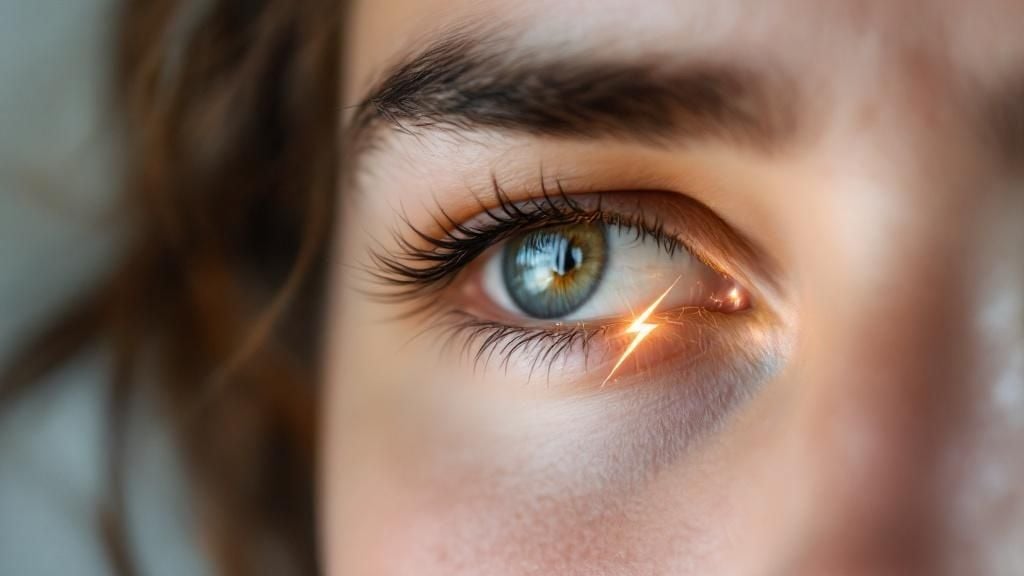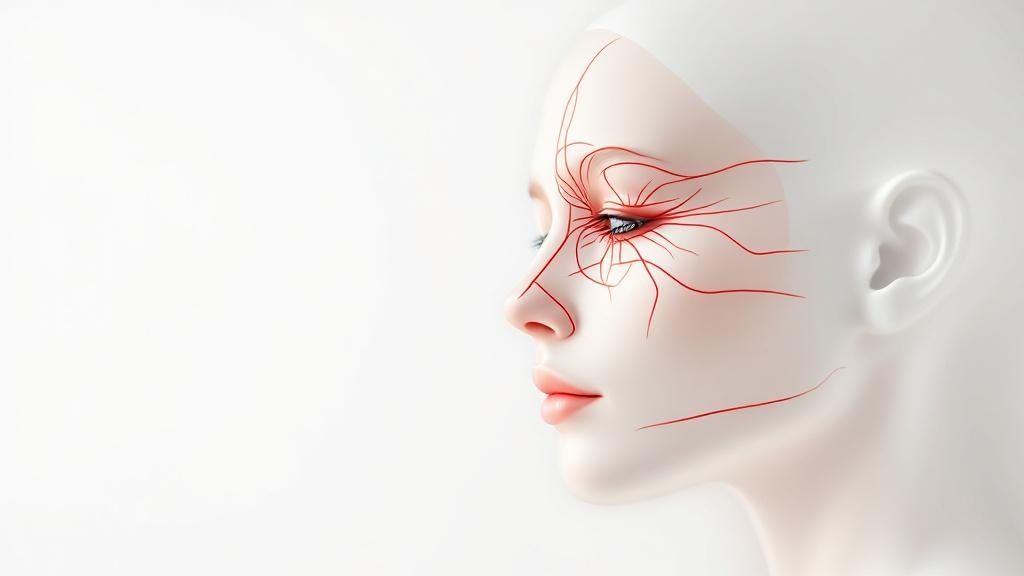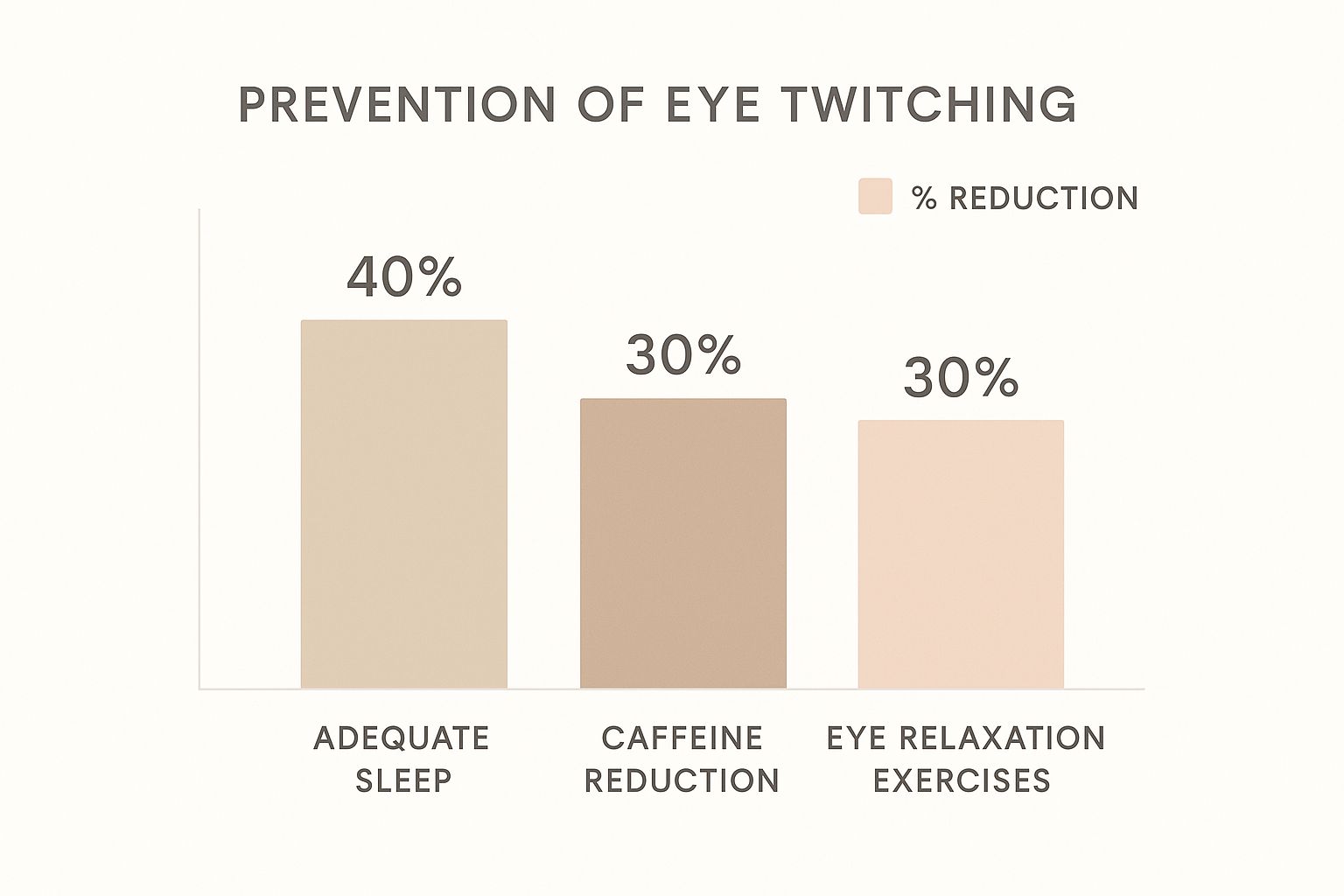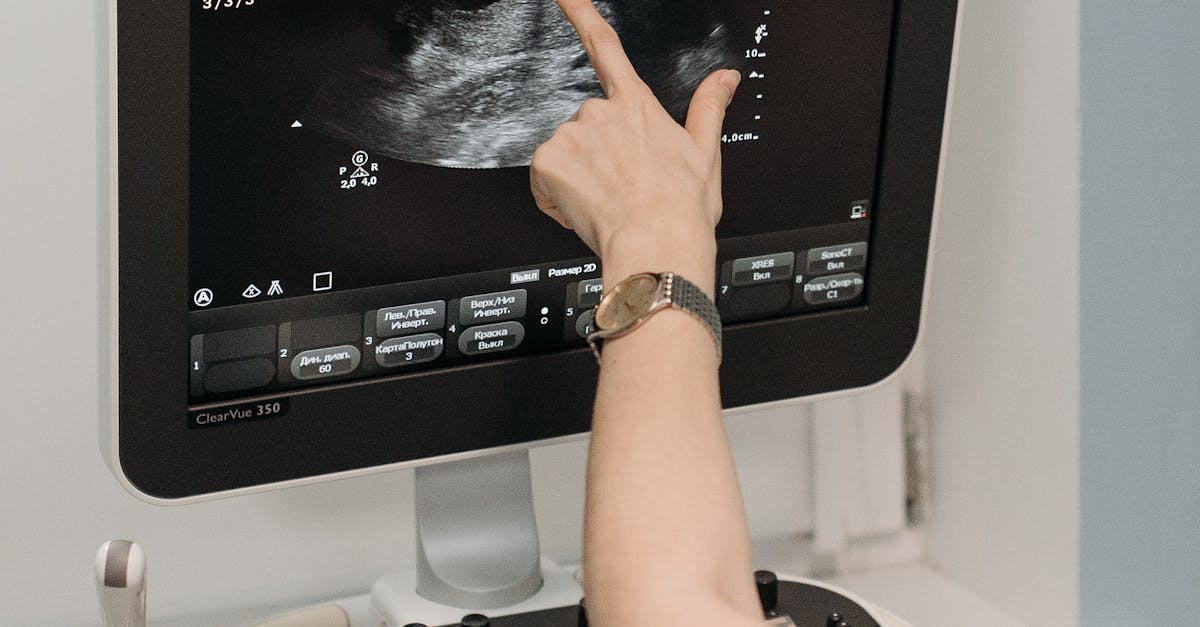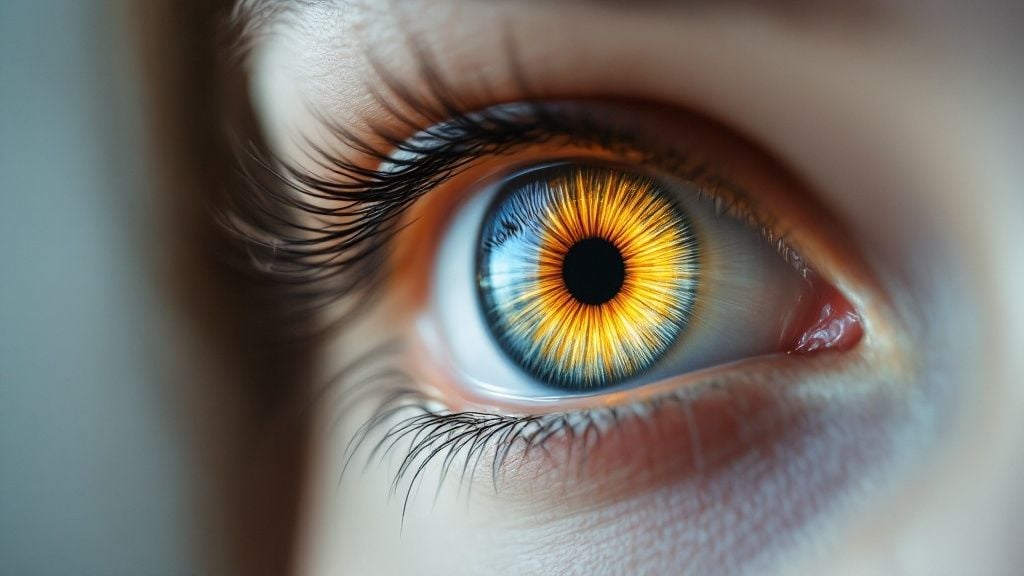That frustrating little flutter in your eyelid? It’s usually a harmless, temporary muscle spasm called myokymia. You can think of it as a brief 'glitch' in the tiny muscles around your eye. Most of the time, it's simply your body’s way of sending a signal that it needs a break. If you've ever been driving down North Avenue or grabbing groceries at the Glendale Heights Valli Produce and felt that annoying twitch, you're not alone.
At iDoctor, the premier optometry boutique serving Glendale Heights and the surrounding Chicagoland suburbs, we often see patients concerned about this common issue. The good news is that this twitch is usually nothing to worry about and almost always goes away on its own. We'll walk through the usual culprits—from your morning coffee habit to too much screen time—and help you understand when it might be time to check in with a professional.
Common Triggers Behind Eye Twitching
So, what exactly makes those delicate eyelid muscles go into overdrive? A few key factors are usually behind that persistent twitch.
- Stress and Fatigue: Life gets busy, and our bodies feel it. When you're stressed out or just plain exhausted, your nervous system can become overactive, sending out extra signals that cause muscle spasms anywhere—including your eyelids.
- Caffeine and Alcohol: That extra cup of coffee or evening cocktail can do more than you think. Both are stimulants that can heighten your body’s sensitivity and increase muscle excitability, sometimes leading to those involuntary twitches.
- Digital Eye Strain: Staring at a computer, phone, or tablet for hours on end is a modern-day reality, and it puts a serious strain on your eye muscles. You can dive deeper into the symptoms of computer-related eye strain in our detailed article.
- Dry Eyes or Irritation: When your eyes aren't properly lubricated, the surface can become irritated. This irritation can sometimes be enough to trigger a twitching reflex as your eye tries to compensate.
Common Eye Twitching Triggers at a Glance
To make it even easier to pinpoint the cause, here’s a quick summary of the most frequent triggers for harmless eyelid twitching. This table can help you quickly identify potential culprits in your daily life.
| Lifestyle Factor | How It Contributes to Twitching |
|---|---|
| Stress | Overstimulates the nervous system, causing muscle excitability. |
| Fatigue | A tired body is more prone to involuntary muscle spasms. |
| Caffeine | Acts as a stimulant that can make muscles more reactive. |
| Alcohol | Can disrupt normal muscle control and nerve function. |
| Eye Strain | Overworking the eye muscles leads to fatigue and spasms. |
| Dry Eyes | Irritation from a lack of moisture can trigger a twitch reflex. |
By paying attention to these common factors, you can often trace your eye twitch back to a simple cause and make small adjustments to find relief.
As your trusted Glendale Heights optometrists, we’re here to provide clarity and peace of mind for all your eye health concerns.
2. How Everyday Habits Trigger Eye Twitching
Ever wonder what's really behind that annoying, persistent eye twitch? More often than not, the answer isn’t some complex medical mystery. It’s usually a simple, direct message from your body, pointing straight back to your daily routines and habits.
Let's unpack the usual suspects that can make those tiny, delicate muscles around your eye go into overdrive.
Stress is a huge one. When you’re under pressure, your body pumps out stress hormones that basically put your entire system on high alert. This constant "fight or flight" mode can easily overstimulate the sensitive muscles in your eyelids, causing them to spasm.
Fatigue is another major culprit. Think of your nervous system like a phone trying to operate on a low battery—the signals from your brain to your muscles can get a bit glitchy. Not getting enough sleep throws everything off balance, and those involuntary twitches are a common side effect. Remember, most adults really do need a solid 7-9 hours a night to fully recharge.
Your Diet and Digital Life
What you're eating and drinking matters, too. Caffeine is a classic stimulant, and that extra espresso might be just enough to tip your already-tired eye muscles over the edge. Alcohol can also be a problem, as it often disrupts your sleep and can lead to dehydration—both well-known triggers for twitching.
And then there's screen time. Staring at a computer or phone for hours on end puts a massive strain on your eyes. It’s like forcing your eye muscles to run a marathon every single day, and eventually, they get exhausted and start to cramp up or twitch.
Key Insight: Think of a temporary eye twitch as your body's check engine light. It's often just signaling an imbalance—too much stress, not enough sleep, or too many hours in front of a screen.
For our patients here in Glendale Heights, we see the impact of prolonged screen use all the time. If your workday involves a computer, learning how to prevent computer eye strain can be a game-changer. By making a few small adjustments to these daily habits, you can often silence that distracting flutter and give your eyes the rest they desperately need.
Environmental and Physical Triggers for That Annoying Eye Twitch
Sometimes, an eye twitch isn't just a random annoyance. It's your body's way of reacting to something happening internally or in your environment. These triggers can be surprisingly subtle, but they're often the real culprits behind that frustrating flutter.
One of the biggest physical culprits we see is dry eyes. When your eyes don't have enough moisture, the surface gets irritated. Think of it like a tiny, invisible scratch that your eyelid muscles react to. This irritation is often what kicks off the twitching reflex. Here in Illinois, the dramatic shift from dry winter air to high-pollen springs can make dry eye symptoms even worse.
For contact lens wearers, this can be a particular challenge. We put together a helpful guide on handling dry eyes and contact lenses that offers practical solutions.
The Impact of Allergies and Nutrition
Beyond just dryness, seasonal allergies are a huge factor for many in the Glendale Heights area. When you're exposed to allergens like pollen or dust, your body releases histamine. This is the same chemical that causes that familiar itching and swelling, which naturally makes you want to rub your eyes. All that rubbing is more than enough to irritate the delicate eyelid muscles and start a spasm.
Your diet can also play a surprisingly important role. Proper muscle and nerve function depends on a delicate balance of electrolytes and minerals.
Important Takeaway: A deficiency in certain minerals, especially magnesium, is a well-known contributor to muscle spasms all over the body, including the eyelids. While it might not be the sole cause, a balanced diet is fundamental for healthy nerve and muscle function and can help keep twitches at bay.
Figuring out these physical triggers is the first real step toward relief. During our detailed eye exams in Glendale Heights, we look for the tell-tale signs of dryness or irritation that might be causing that twitch. This allows us to get to the root of the problem and recommend a solution that actually works.
When an Eye Twitch Signals Something More
Most of the time, that annoying little eyelid flutter is just a temporary nuisance—a harmless blip in your day caused by stress or a little too much coffee. But every once in a while, a persistent spasm can be your body’s way of flagging a deeper issue. It's helpful to know the difference between a simple twitch and one that needs a professional look.
The typical, mild flutter you feel in one eyelid is known as myokymia. It's common and almost always benign. However, some neurological conditions can trigger much more forceful, involuntary contractions that can be strong enough to squeeze the eye shut. These include conditions like Benign Essential Blepharospasm (BEB) or a Hemifacial Spasm, which often involves other muscles on one side of your face.
Knowing the Warning Signs
This isn't about causing alarm, but about empowerment. When you know what to look for, you can make an informed decision about seeking care.
Think of it as your body sending out signals. A minor twitch is a quiet notification, but these symptoms are more like a persistent alarm bell:
- It won't quit: The twitch hangs around for several weeks or more without letting up.
- It's spreading: What started in your eyelid is now affecting your cheek or the corner of your mouth.
- It's forceful: The spasms are strong enough to make your eyelid close completely.
- It brings friends: You also notice redness, swelling, unusual discharge from the eye, or changes in your vision.
For those everyday, harmless twitches, simple lifestyle adjustments can make a world of difference.
As you can see, simply getting enough quality sleep can be the most effective strategy for calming a twitchy eye.
Harmless Twitch vs. When to See a Doctor
It can be tough to tell what's "normal." This quick comparison should help you spot the differences between a common twitch and symptoms that warrant a visit to the doctor.
| Symptom | Common (Myokymia) | Consult a Doctor (e.g., BEB/HFS) |
|---|---|---|
| Location | Usually just one eyelid (upper or lower) | Both eyes may be affected, or it spreads to other facial muscles |
| Severity | A light, fine flutter or quiver | Strong, forceful contractions that can clamp the eye shut |
| Duration | Lasts a few hours or days; often comes and goes | Persists for weeks or months without relief |
| Associated Signs | None—just the twitch itself | May be joined by redness, swelling, discharge, or light sensitivity |
If your symptoms lean toward the right-hand column, it’s a good idea to schedule an appointment for a professional evaluation.
While rare, a condition like BEB affects an estimated 1.6 to 30 per 100,000 people, and it tends to be diagnosed more often in women. Interestingly, some other schools of thought also see meaning in a twitch; from a Traditional Chinese Medicine perspective, it can sometimes be a sign of an internal imbalance, such as Liver Qi Stagnation.
If any of these more serious or persistent symptoms sound familiar, a thorough eye exam is the best next step. We can help you get to the bottom of it by revolutionizing eye care with digital retinal imaging, which gives us a detailed view of your eye health.
Finding Relief at Home and in Our Clinic
When you're dealing with a mild, occasional eye twitch, the solution is often right at home. These first-step strategies are all about calming those overworked muscles and tackling the common culprits behind the twitching.
A simple warm compress held gently over the eye for a few minutes can work wonders to relax the spasming muscle. It's also a good idea to stay hydrated and use some over-the-counter lubricating eye drops, as these can combat the irritation from dryness that frequently sets off a twitch.
At-Home and In-Clinic Solutions
Sometimes, small tweaks to your daily routine can make all the difference. Think of it as hitting the reset button on your habits.
Here are a few practical steps to try:
- Manage Your Stress: Stress is a massive trigger for eye twitching. Finding ways to unwind is key. This comprehensive guide to reducing stress naturally has some great, actionable ideas.
- Ease Up on Stimulants: That extra cup of coffee or evening glass of wine might be contributing. Cutting back can help calm your nervous system and reduce those muscle spasms.
- Get Your Sleep: Your body does its best repair work overnight. Aiming for 7-9 hours of quality sleep gives your eyes and your entire nervous system a chance to recover.
But what if the twitching just won't quit? If it hangs around for more than a week or starts to get in the way of your day, it's time to get a professional opinion.
Here at iDoctor, our detailed eye exams in Glendale Heights go beyond a simple vision check. We use advanced high-resolution imaging to get to the root of the problem, whether it's something like chronic dry eye syndrome or another underlying issue. You can learn more by checking out our guide to effective dry eye treatment options.
Expert Tip: Think of a persistent twitch as your body's check-engine light. A professional exam helps us figure out if it's a minor annoyance or a sign of a condition that needs a specific treatment plan.
If light sensitivity is the problem, we can help with that, too. We can fit you with premium sunglasses from top brands like Tom Ford, Fendi, and Gucci, available right in our Glendale Heights boutique. Our goal isn't just to provide a quick fix—it's to find a lasting solution that's a perfect fit for you.
Your Eye Twitching Questions Answered
We get a lot of questions about eye twitching from our patients here in Glendale Heights. It's a common annoyance, so here are a few of the most frequent things people ask us.
How can I find the best optometrist in Glendale Heights for my eye twitch?
Finding the right optometrist means looking for a practice that invests in modern technology and takes the time to understand your lifestyle. At iDoctor, our 30-minute detailed exams use high-resolution imaging to pinpoint the cause of issues like eye twitching. We provide a warm, professional, and approachable atmosphere for all our patients.
Does my vision insurance cover an exam for eye twitching?
Yes, in most cases, an exam to investigate a persistent eye twitch is covered. Since a twitch can be a symptom of an underlying medical issue like dry eye syndrome or digital eye strain, the evaluation is considered medically necessary. iDoctor proudly accepts all major vision insurance plans, and our team is happy to help you understand your specific benefits.
Can new designer eyeglasses in Glendale Heights help reduce eye twitching?
They absolutely can. If digital eye strain is the culprit, we can fit you with lenses that have advanced blue light filtering. If light sensitivity is a trigger, a pair of high-quality sunglasses can offer significant relief. Our Glendale Heights boutique features a curated collection of luxury eyewear from brands like Cartier and Oliver Peoples, as well as trusted names like Ray-Ban, ensuring you find a solution that is both effective and stylish.
Ultimately, your vision and comfort are what matter most. Whether you’re a student at Glenbard North High School or dealing with the daily commute on Army Trail Road, you shouldn't have to put up with a persistent eye twitch. The dedicated team at iDoctor is here to find the cause and bring you relief.
At iDoctor, we pair advanced clinical care with luxury eyewear to offer an experience you won't find anywhere else in Glendale Heights. Schedule your appointment today and see the difference for yourself.

